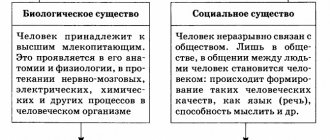Socio-psychological approach to understanding personality
Since ancient times, people have discovered the dependence of their behavior on the surrounding social environment, as well as on their own psyche, which forced them to adapt to living conditions, while demonstrating the ability to make free choice. Such a connection between the psyche and external influences and stimuli has been noted in the history of psychology in many previous theories and concepts for studying the problem of the relationship between the “individual” and the “social” in personality. The analysis of this problem, based on psychological research and philosophical foundations, is anthropological, according to which man is primarily a biological being. Their role and place in society is determined, and the priority of the social environment in shaping personal development is taken as a basis.
We use the concept of “personality” as developed to reflect the social nature of a person, consider him as a subject of sociocultural life, define him as a bearer of an individual principle, revealing himself in the context of social relations, communication and subjective activity. Moreover, this concept can mean either a human individual as a subject of relationships and conscious activity, or a stable system of socially significant traits that characterize a person as a representative of a community or social group. However, first it is necessary to clarify the specifics of understanding personality in social psychology.
Various socio-psychological theories of personality, considering them in different aspects, proceed both from the interests of the individual, the priority of his communicative, moral potential in professional development, his knowledge, style and culture of communication, and from the importance of society, social relations in the formation of personality. Depending on the prevailing aspect of this phenomenon, a theoretical justification of a certain type and social program of human behavior, a certain strategy of action, and other socio-psychological qualities and characteristics of the individual takes place.
Today, many scientific theories involved in the study of the human psyche theoretically and experimentally confirm that the latter is not a consequence or a direct continuation of the natural evolution of elementary forms of animal behavior. Therefore, it is clear that our mental functions are formed in the process of our upbringing and development in society, through the assimilation of social experience by all of us. It should be noted that this process of assimilation is a special form of mental development that can only be inherent in humans. Here we are talking not only about higher mental functions (abstract thinking, logical memory, etc.), but also about such elementary and, at first glance, innate functions (for example, tonal hearing), which are social in nature and develop over time. life.
According to our most famous psychologist and founder of Russian neuropsychology A.R. Luria: the actual functional systems of the brain, as the material substance of mental functions, do not appear ready-made at birth and do not mature independently, but are formed in the process of communication and objective activity of a growing person. Luria A.R. Lectures on general psychology; collection of lectures, St. Petersburg: Peter, 2006 - 320 p. In reality, there are no natural programs for human social behavior, since social life itself is not a constant system of factors, but changes, often much faster than the change of generations.
A number of psychologists substantiate the socialization of the individual as a transition from purely biological to social stages of development and understand socialization as a process of learning and adaptation. In reality, social relations, through their actions, transform natural functions into social ones and put them at the service of social development. At the same time, the social does not destroy the natural, but unites it into new systems of contexts and relationships, which are governed by qualitatively new laws of the social form of movement.
Psychology of Personality
1.3. Temperament
Temperament is a set of individual characteristics that characterize the dynamic and emotional aspects of human behavior, his activities and communication. Only conditionally can temperament be classified as a personality component, since its characteristics, as a rule, are determined biologically and are innate. Temperament is closely related to character, and in an adult it is difficult to separate them.
Temperament can be divided into four most general types: choleric, sanguine, phlegmatic, melancholic. This division has a long history (Hippocrates, Galen, Kant, Pavlov, etc.), although there are other classifications of temperament types (Kretschmer, Sheldon, Seago, etc.).
1. Choleric is a strong type of temperament, manifested in general mobility and the ability to devote oneself to a task with exceptional passion, in violent emotions, sudden changes in mood, and imbalance.
2. Sanguine is a strong type of temperament, characterized by mobility, high mental activity, variety of facial expressions, responsiveness and sociability, and balance.
3. Phlegmatic - a strong type of temperament associated with slowness, inertia, stability in aspirations and mood, weak external expression of emotions, and a low level of mental activity.
4. Melancholic is a weak type of temperament, which is characterized by slowness of movements, restraint of motor skills and speech, low level of mental activity, slight vulnerability, a tendency to deeply experience even minor events, a predominance of negative emotions, and sensitivity.
There are no good or bad temperaments. Each of them has its own advantages and disadvantages. The advantage of a choleric person is the ability to concentrate significant efforts in a short period of time, but the disadvantage is that during long-term work he does not always have enough endurance. A sanguine person, having a quick reaction and increased work capacity in the initial period of work, by the end of work reduces his work capacity not only due to rapid fatigue, but also due to a loss of interest. The advantage of a phlegmatic person is the ability to work long and hard, but he is not able to quickly get together and concentrate his efforts. A melancholic person is distinguished by great endurance, but slow entry into work; his performance is higher in the middle or at the end of work, and not at its beginning.
The type of temperament must be taken into account in specialties where work places special demands on the dynamic and emotional qualities of a person.
Properties of temperament
. Temperament and personality. Most researchers of temperament identify the following properties that are closely related to each other and to qualities of character: sensitivity - a human characteristic that manifests itself in the occurrence of sensitivity (mental reaction) to an external stimulus of the least strength; reactivity is a human characteristic associated with the strength of the emotional reaction to external and internal stimuli; activity - a person’s ability, which consists in overcoming external and internal restrictions in production, in socially significant transformations, in appropriating wealth, and assimilating spiritual culture; the pace of reactions is a feature of a person, which consists in the speed of mental processes, and to a certain extent, mental states; plasticity - rigidity - the characteristics of a person to adapt flexibly and easily to new conditions, or to behave skeletally, inertly, insensitively in changed conditions; extroversion-introversion - human characteristics, expressed in the predominant direction of personality activity either outward (to the world of external objects: surrounding people, events, objects) or inward (to the phenomena of one’s own subjective world, one’s experiences and thoughts).
Temperament
, being innate, is the basis of most personality traits. But it only determines the dynamics of their manifestation (sensibility, emotionality, impulsiveness, anxiety).
Impressionability
- a human property that characterizes the degree of influence of various stimuli, the time they are stored in memory and the strength of the response to this influence.
Emotionality
- a property expressed in speed, content, quality, depth, dynamics of emotional processes and states.
Impulsiveness
- a property consisting in a person’s tendency to act on the first impulse, spontaneously under the influence of external influences or suddenly surging emotions.
Anxiety
- an increased tendency of a person to experience anxiety in any situation in life, including those not conducive to it. The concept of anxiety is close to the concept of neuroticism (G.I. Eysenck).
These features of temperament influence characterological traits, the development and manifestation of a person’s abilities.
Practical tasks
1. How can we define temperament?
2. What are temperament types?
3. How do temperament, activity and communication interact?
4. What personality traits should be classified as temperament properties?
5. What is the relationship between temperament and personality?
6. What type of temperament - choleric, sanguine, phlegmatic or melancholic - do the following characteristics correspond to:
a) Somewhat slow reactions, stable mood, outwardly little expressed emotional sphere. Remains quite self-possessed and calm, does not allow impulsive movements in difficult life situations. Shows great persistence in completing a task, correctly calculating his strength. Stereotypes of mating, behavior is often not flexible enough, switching of attention, activity and communication is slowed down to a certain extent. He achieves the greatest success in professions that require perseverance, uniform effort, stability of attention and great patience.
b) Increased emotional reactivity, sharp pace and speed in movements, greater energy and straightforwardness in relationships. Under unfavorable conditions, increased excitability can lead to short temper and, in some cases, aggressiveness. Sudden change of mood. Able to overcome significant difficulties, devote himself to work with great passion with correspondingly high motivation. Achieves the greatest results in professions that require increased reactivity and significant simultaneous effort.
c) Increased vulnerability, a tendency to experience deep emotions even for minor reasons. Feelings arise easily, are poorly contained, and are clearly expressed outwardly. Strong external influences make it difficult for him to function and communicate. Closed, avoids new surroundings. Under unfavorable living conditions, shyness, timidity, indecision, as well as cowardice quickly arise. But in a favorable, stable environment, he can achieve significant success in professions that require increased sensitivity (sensitivity) and reactivity;
d) Easy adaptability to changing living conditions, increased contact with other people, easy emergence and rapid change of feelings, stereotypes are quite flexible, relaxed in a new environment, capable of quickly switching attention, activity and communication. The most successful types of profession require quick reactions and increased sociability.
TEST
Identify yourself using a personality questionnaire
Eysenck (EPI). A simplified male version is given (women make appropriate adjustments to the questions). Answer “yes” or “no” to the following questions (work quickly, without spending a lot of time thinking, your first reaction is important, and not the result of long thoughts, you need to answer every question without missing a single one).
1. Do you often feel a craving for new experiences, to shake yourself up, to experience excitement?
2. Do you often need friends who understand you and can encourage and console you?
3. Are you a carefree person?
4. Do you find it difficult to answer “no”?
5. Do you think before you do anything?
6. If you promised to do something, do you always keep your promise?
7. Do you often have ups and downs in your mood?
8. Do you usually act and speak quickly, without thinking?
9. Do you often feel like an unhappy person without sufficient reasons?
10. Would you do anything for a dare?
11. Do you feel shy or embarrassed when you want to start a conversation with an attractive stranger?
12. Do you sometimes lose your temper and get angry?
13. Do you often act under the influence of a momentary mood?
14. Do you often worry because you have done or said something that you should not have done or said?
Social and psychological structure of personality
The main problem in the study of personality is understanding its psychological structure. Structural analysis of personality is one of the most important tasks of both sociology and social psychology. In particular, socio-psychological research has done a great job of studying the socio-psychological structure of personality, which has a huge empirical base. The problem of personality structure is one of the most pressing in socio-psychological theory; in contrast to the widespread idea of personality structure, it does not relate to the personality structure in general, but to different approaches to its construction and, accordingly, to two qualitatively different models of personality structure: static and dynamic.
A static structure should be understood as an abstract model that characterizes the main aspects, layers or components of the individual’s psyche. The degree of generality of such a model can vary widely. This depends on what instrumental approach to the static structure of personality the researcher uses - analytical or integral. The dynamic structure model reflects the main components of the individual’s psyche. By dynamic personality structure we mean a model of a person’s mental state and behavior, which allows us to understand the mechanisms of interrelation and interaction of all components and structural layers in the individual’s psyche.
The structure of the human personality, as a very complex phenomenon, is a combination, hierarchy and a certain interaction of various elements. Each structure is characterized by a certain stability and at the same time is subject to various changes - progressive and regressive - up to disintegration, which is characterized by the concept of destruction. Destructive phenomena in the personality structure lead to deviations, which are called deviant behavior. Characterizing the model of the socio-psychological structure of personality, two main parameters can be distinguished. Firstly, that which relates to defining the nature of the model itself, which can be static or dynamic, and secondly, that which relates to defining the instrumental approach to research, which can be analytical or integral.
Universal mental characteristics of an individual. What is universal in the human psyche is, firstly, the presence of the necessary complex of basic mental processes (sensation, perception, memory, thinking, will) and states that obey psychophysiological mechanisms common to all people, without which it is impossible to talk about the mental activity of the individual; Secondly, the fact of biosocial determination of the mental world and human behavior (the result and manifestation of the latter are such stable traits and characteristics of a person as his temperament and character); thirdly, the fact of the sociality of the human psyche, in contrast to the psyche of animals.
Socially specific experience. In addition to universal human experience, it is necessary to highlight the socially specific experience of the individual. This refers to all those features of the individual’s psyche that are associated with the fact of his belonging to a certain social community or set of social communities (ethnic, class, political, ideological, economic, professional, national, etc.). What the above elements of an individual's socially specific experience have in common is that they all perform specific functions that authorize, regulate and direct the individual's behavior. Refer specifically to those specific forms of reflection by the individual of social reality that are extremely generalized, impersonal in nature (roles, norms, values, symbols).
Social norms. The term "social norm" is widely used in sociology and social psychology to refer to rules or patterns of behavior sanctioned by social groups and expected in the actual behavior of members of those groups.
Definition of personality in different sciences
In sociology, the concept of personality is studied in the process of relationships between people, as well as as a separate element of the social system. In addition, sociology conducts the study of personality when it is still being formed, in the process of its formation and the acquisition by an individual of certain qualities characteristic only of him. In contrast to legal science, which looks at this as a completely ready-made and formed concept.
In jurisprudence, a person is understood as an individual who has certain rights, freedom of action and obligations as an ordinary person and as a citizen in general. This concept refers to the personality of a specific person who has a number of socially important qualities that manifest themselves in relationships with other people.
Social psychological theories of personality
Today there are many different socio-psychological theories of personality, which give us the opportunity to talk about it as an individuality and at the same time as a socio-psychological phenomenon. There is no general theory of personality in social psychology; this is mainly due to the history of the development of social psychology itself, where by the middle of the last century four main approaches to explaining personality and social behavior had emerged: neo-behaviourist, cognitive, psychoanalytic and interactionist. All but the fourth correspond to general psychological trends, and the latter has sociological roots. All of them are characterized by general theoretical principles of analysis and interpretation of an individual’s social behavior and contain a number of specific socio-psychological theories of personality, the so-called “middle stage theories.”
The most well-known socio-psychological theories of personality today include, first of all:
- Psychoanalysis (3rd Freud, K. Jung, A. Adler, etc.);
- School of behaviorism (behaviorism);
- Understanding personality from the perspective of humanistic psychology (A. Maslow, K. Rogers);
- The study of personality in the context of existential psychology;
- Transactional analysis of personality (E. Bern);
- Acmeological approach to understanding personality (O. Bodalov, A. Derkach, L. Orban-Lembrick, etc.);
- Strategy for living the personality of Abulkhanova-Slavskaya;
- Social and psychological concepts of personality.
Let's briefly look at the main provisions of these theories.
Psychoanalysis. Sigmund Freud, the founder of psychoanalysis, laid the foundations for one of the most profound teachings about human personality. Psychoanalysis is based on two doctrines:
The doctrine of mental determinism. This means that every psychological phenomenon has a cause;
The assertion that unconscious processes play a much greater role in shaping human thinking and behavior than conscious processes.
Freud believed that the most important personal determinants are hidden in the unconscious, that here is the main source of mental energy, drives, and instincts.
Swiss scientist Carl Jung viewed personality as a complex structural phenomenon based on the idea of the coexistence of the individual unconscious with the collective unconscious. The collective unconscious contains archetypes, specific forms of ideas that are filled with personal figurative and emotional content throughout the life of the individual. Another famous Jungian idea is introversion and extroversion. Jung proposed a typology of character in accordance with the presence of predominant functions (thinking, feeling, intuition) and the orientation of the individual towards the internal or external world.
Jung also coined the terms introversion and extroversion to define two contrasting personality types. Extroverts are focused on the outer world, while introverts are focused on their inner world. On this basis, Jung identified eight typological groups based on four types of orientation (thinking, emotions, feelings, intuition) and two personality attitudes (introversion and extraversion).
Biosocial approach to the formation and development of personality
Representatives of this approach affirm the special role in the process of individual development not only of the external environment and upbringing, but also of heredity.
To prove this point of view, A. Etkind cites the results of experimental studies, according to which neither the situation (external factors, “environment”), nor the personality (inclinations, heredity) can predetermine the characteristics of a person’s mental development. The influence of these factors is noted only in aggregate and continuous interaction, that is, two-factor concepts of determining personality development have received the right to exist. And in an attempt to answer the question of how “environment” and “heredity” are related, V. Stern’s theory of the convergence of two factors was formulated.
Preface
The history of human life, regardless of the cultural context in which it takes place, is an eventful and exciting work of drama. The complex study of human development in context (see glossary) is a challenging task for students and scholars alike. The ninth edition of “Developmental Psychology” ( Human
development , ninth edition )
combines data taken from various branches of scientific knowledge (psychology, biology, sociology, anthropology, history, child care and education, medicine and health care - just a few of them) . This approach will help provide the most comprehensive contemporary overview of the key themes, issues and controversies associated with human development throughout the life course.
I once again collaborated on this edition of Developmental Psychology with Don Baucum, an experimental psychologist and accomplished clinician whose personal observations, eclectic teaching experience, and engaging writing style helped bring life to this narrative and give it its unique identity. When preparing the previous edition, we discovered that the personal experience of each of us in the practical psychological activity of studying the problem of development, supported by extensive teaching experience, combined with the experience of the other, significantly strengthen each other. Now Don is my full-fledged co-author. Together, we strive to offer you an in-depth, often thought-provoking overview of contemporary developmental theory and research and its applications in everyday life. Because the field is so broad, open, controversial, and challenging, students will find a wide variety of perspectives, approaches, and experimental evidence. Readers will be able to analyze the information presented here, relate it to their personal experiences, and develop an informed, critical view of the process by which we become who we humans are and the events that each of us experiences in our lives. right to expect in the future.
How do we see students today?
Today's college students are much more different from each other than they used to be. If we use the results of a cross-sectional study, we can find within a single classroom a sample that varies widely in age, ethnicity, personal experience, and worldview. In addition, students vary greatly in their academic performance, particularly their exposure to the social sciences, and in their career aspirations. Each of these (and many others!) factors creates “filters” through which each individual perceives human development and life in general. Many of those who study human development today will tomorrow work in fields related to helping people, such as social work, education, medicine, counseling, various areas of psychology, and management programs. Some of them are already parents, many are yet to become parents in the future; for this reason, the book includes a large number of practical tips for young parents related to raising and caring for children.
We believe that most students, of course, have a pronounced, deep interest in the problems of childhood, adolescence and adulthood. By describing the variety of issues and problems, we support this interest in human development. Developmental psychology presents people as they are within the context of culture and subculture, both in the United States and abroad. Rather than starting from a specific group and making generalizations on that basis, the book makes a special effort to explain how the phenomenon of development applies or relates to a wide range of people. This diversity is reflected in the contemporary research and case studies described herein. It is hoped that in the pages of this book students will find a description of themselves, regardless of background and other factors, and at the same time will be able to avoid the restrictions imposed by ethnocentrism.
Chronological organization of material
When compiling and writing papers on human development, there is always the question of organizing the material. You can organize developmental research and theory into thematic chapters on biological, cognitive, language, social, and personality development, or you can present child and adult development chronologically as it occurs in nature, emphasizing holistic relationships. Developmental Psychology takes the latter approach and describes in separate chapters each of the age periods into which human life is traditionally divided: prenatal period, infancy, early childhood, middle childhood, adolescence and young adulthood, and then early, middle and late adulthood. . The book opens with two chapters on approaches to human development and methods of studying it, followed by a chapter describing the interaction of heredity and environment, and a chapter on prenatal development, and the book ends with a chapter on death and dying. In the middle of the book, between the sections already mentioned, there is data on the main age periods, each of which is described in two successive chapters: the first on physical and cognitive development and the second on social, cultural and personality development. Despite these necessary divisions, we do not cease to remember the decisive importance of the complex interaction of many diverse facets of development, in contact with which a whole person emerges.
Description of the features of the presentation of the book material that contribute to its study
Throughout the book, cultural and individual aspects of development are discussed in conjunction. Information provided in special boxes along the text also contributes to the perception of the text as a whole. In the section entitled "Issues in Human Development Research,"
a wide range of data and opinions is presented, which promotes further independent reflection and discussion.
Opinions and Facts
examines common popular beliefs about development, sometimes supported and sometimes refuted by scientific evidence.
Finally, Development in Contemporary Life
addresses important contemporary issues in development theory and practice.
Each chapter of this book opens with a "Preview"
which offers questions designed to stimulate interest in the main topics covered here.
After each substantive part of the chapter, there is a “Control Questions” section,
which includes a list of questions formulated according to the “true-false” principle, and one substantive
“Question for reflection”,
to answer which you need to demonstrate the ability to critically comprehend the material.
The answers, as well as a list of additional questions, are provided on our online support site, which will be discussed in more detail below. Throughout the book, to make the information easier to understand, the text is accompanied by numerous tables that provide brief overviews of various viewpoints, additional terms, and current statistics. The figures illustrate discussions of complex topics, research materials, etc., and also present us with current statistics in graphical form. The chapters conclude with a “Summary”
that summarizes the main topics and issues discussed therein.
Definitions of key terms are collected in a comprehensive Glossary
located at the end of the book.
Media Support for the 9th Edition of Developmental Psychology
The Support website for the 9th Edition of Developmental Psychology
is located at www.prenhall.com/craig.
Written by Don Bokum, this online study guide provides students with overviews of the material in each chapter, allows them to complete quizzes, and see their results immediately. In addition, each chapter includes a list of links to additional Internet resources for studying coursework topics. Each chapter contains a description of the goal, multiple-choice questions, true-false questions, fill-in-the-blank assignments, essays, web directories, and answers to the “Test Yourself” section. Test questions” located in each chapter. Online training courses.
For professors interested in incorporating the Internet and online coursework into their courses,
Prentice Hall
offers fully customized online programs in
WebCT , Black - Board
, and
Course Compass
supported by
Blackboard .
For more information, visit www.prenhall.com/demo.






